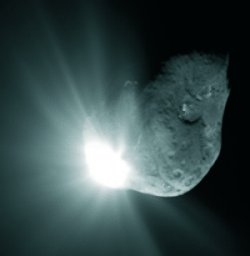Scientists are still digesting data from the first-ever deliberate collision between a spacecraft and a comet. Several space- and ground-based instruments observed an immense flash of light and plume of debris as NASA’s 370kg (820lb) Deep Impact probe vapourised in its 10km/s (6 miles/s) collision with the comet 9P/Tempel 1 on 4 July.

The collision was imaged from Earth orbit by the Hubble Space Telescope, by the European Space Agency’s (ESA) Rosetta probe en route to its own comet rendezvous, and by the Deep Impact fly-by spacecraft. The probe itself sent back images during the comet’s approach, the last at a distance of 30km and with a resolution of about 4m (13ft).
Debris was seen coming from the comet for several hours after the impact, including primordial material from beneath the surface. Data from ESA’s XMM-Newton X-ray telescope indicated emissions of hydroxyl ions, the direct decay product of water. The outgassing could continue “for weeks”, says principal scientist Mike O’Hearn.
Source: Flight International























